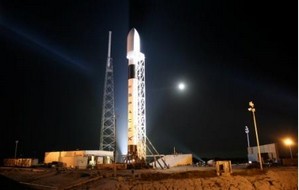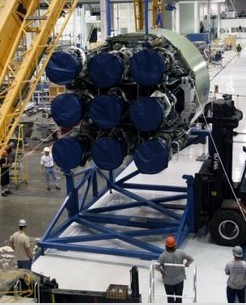Robust Servo Motors Survive Launch Conditions to Optimize Rocket Fuel Burn

Amid tightening budgets, space agencies are increasingly looking to the commercial space sector to provide the launch vehicles of the future, and Space Exploration Technologies (SpaceX) is right there to help. The company builds high-reliability, economical launch vehicles like the Falcon 9 to carry a range of payloads into orbit (see figure 1). One way to control cost is by optimizing fuel burned during launch to minimize waste. The SpaceX team ensures top performance with the help of a special fuel-trim valve, powered by robust, reliable servo motors from MICROMO (the FAULHABER Group).
Rockets like the Falcon 9 and Falcon 1 at SpaceX burn a fuel known as RP-1, a highly refined form of kerosene that must be mixed with oxygen in order to burn. On the launch vehicle, 4-in pipes run from tanks of RP-1 and liquid oxygen (LOX) to combine prior to entering the combustion chamber.
The combustion chemistry of RP-1 is forgiving. The fuel won’t burn without oxygen, but as long as oxygen is present, the two do not need to be combined in a precise ratio. “If the mixture is slightly lean, it is still going to burn decently," says Juerg Frefel, Avionics Engineer at SpaceX. The problem is that if the ratio of LOX to RP-1 varies from the optimum mix, either the oxygen will run out before the fuel or the fuel before the oxygen. Once combustion stops, the material left becomes dead weight, turning from propellant to liability. To ensure this doesn’t happen, the fuel-trim valve adjusts the mixture in real time.
 The fuel-trim device consists of a servo-motor-controlled butterfly valve. To achieve the proper speed and torque, the design incorporates a planetary gearbox for a roughly 151:1 reduction ratio, plus additional gearing internal to the unit. The team qualified the components with a significant safety margin to protect against common-mode failure. The shaft of the motor interfaces with the valve directly to make fine adjustments. “The basic mixture ratio is given by the sizing of the tubes, and a small amount of the flow of each one gets trimmed out,” explains Frefel. “We only adjust a fraction of the whole fuel flow.”
The fuel-trim device consists of a servo-motor-controlled butterfly valve. To achieve the proper speed and torque, the design incorporates a planetary gearbox for a roughly 151:1 reduction ratio, plus additional gearing internal to the unit. The team qualified the components with a significant safety margin to protect against common-mode failure. The shaft of the motor interfaces with the valve directly to make fine adjustments. “The basic mixture ratio is given by the sizing of the tubes, and a small amount of the flow of each one gets trimmed out,” explains Frefel. “We only adjust a fraction of the whole fuel flow.”
The Falcon 9 launch vehicle is a two-stage vehicle with a total of ten engines, each with its own fuel-trim valve. To ensure the proper mix, the valve operates in a double closed loop based on feedback from a triplicate feedback mechanism. The first stage features nine engines that burn for approximately three minutes, and the second stage includes one engine that burns for approximately seven minutes (see figure 2). Because of the duration of the burn for each stages, the control loops can actually run relatively slowly. “The whole valve doesn't necessarily need to be fast,” says Frefel. “It's a closed-loop system, which means that the command to the valve is to go to a certain angle. The outer loop adjusts the angle of the valve and the inner loop keeps the position steady in case it gets pushed around [by shock/vibration].”
Tough Enough Accuracy aside, the characteristics most applications require from servo motors tend to be high torque, high speed, or small size. In the case of the fuel-trim valve, the chief motor requirement was simple: They had to survive launch. The shock and vibration produced in the first stage, in particular, are extreme (see figure 3). “For the three minutes of the first stage, the engine is producing 100,000 lb. of thrust,” says Frefel. “It's quite a violent event and [the fuel-trim valve] is right next to the engine.”
 When the engineering team set out to qualify components for the fuel-trim valve, vibration testing caused motor after motor to fail. “We have vibration fixtures and tables here where we can simulate the engine environment,” says Frefel. “We basically went through a whole bunch of motors from different vendors to see which one would hold up." To minimize points of failure, they switched from brushed to brushless motors. “The main performance issue for us was could it survive the environment? That meant that the gearbox stayed on, the Hall-effect sensors weren’t damaged, that nothing bad happened in the extreme environment. We just [kept looking] until we found the manufacturer of motors that survived.” In the end, that manufacturer was MICROMO.Rocket engines produce heat as well as vibration, but contrary to what a person might think, thermal management does not pose a significant challenge in this application.Much of the heat is radiated and is reflected away. In addition, given the relatively brief duration of the stages, the unit’s thermal mass makes it resistant to rapid temperature swings. “The actuator still has three to four pounds of mass, which means that in three minutes it doesn't heat up that dramatically,” Frefel says.
When the engineering team set out to qualify components for the fuel-trim valve, vibration testing caused motor after motor to fail. “We have vibration fixtures and tables here where we can simulate the engine environment,” says Frefel. “We basically went through a whole bunch of motors from different vendors to see which one would hold up." To minimize points of failure, they switched from brushed to brushless motors. “The main performance issue for us was could it survive the environment? That meant that the gearbox stayed on, the Hall-effect sensors weren’t damaged, that nothing bad happened in the extreme environment. We just [kept looking] until we found the manufacturer of motors that survived.” In the end, that manufacturer was MICROMO.Rocket engines produce heat as well as vibration, but contrary to what a person might think, thermal management does not pose a significant challenge in this application.Much of the heat is radiated and is reflected away. In addition, given the relatively brief duration of the stages, the unit’s thermal mass makes it resistant to rapid temperature swings. “The actuator still has three to four pounds of mass, which means that in three minutes it doesn't heat up that dramatically,” Frefel says.
Interestingly, the thermal issue he does mention is low, not high temperatures. During the second stage, for example, the engines may fire only briefly. The vehicle can then coast for as long as 45 min before a second burn takes place. By this point, the rocket is outside of the atmosphere, where temperatures can be quite low.
To control cost and production timelines, the SpaceX philosophy is to try to work with stock components whenever

possible. Nothing special was done to the MICROMO motors to ruggedize them for the application; the design team simply ordered standard products. Leveraging MICROMO's express prototyping program, the SpaceX team was able toobtain samples in very short time frames. "They were either in stock in the United States or they had them within a few days," said Frefel. “They do a good job of having small volumes that can allow you to try out different gear ratios for different topologies. I was quite impressed by how easy it was.
"As schedule and budgetary pressures cause NASA to increasingly lean toward commercial orbital transportation services, opportunity in this sector is on the rise. With the help of MICROMO, SpaceX delivers robust, reliable technology at an appealing price point.










发表评论共有0访客发表了评论
暂无评论,快来抢沙发吧!